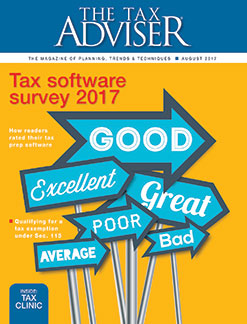- column
- From the Tax Adviser
Use of trust disclaimers in estate planning
Please note: This item is from our archives and was published in 2017. It is provided for historical reference. The content may be out of date and links may no longer function.
Related
Why 2026 is another ‘big tax year’
IRS clarifies health savings account changes in H.R. 1 in new notice
PTEs need more notice of changes, more time to respond, AICPA says

A taxpayer may have established a trust long ago for a specific purpose only to have life circumstances and/or legislative changes derail a well-thought-out estate plan. The use of a disclaimer by a trust beneficiary may be helpful to adjust the results of a previously established irrevocable trust.
A disclaimer is essentially a refusal of a gift or bequest. For example, if a parent dies and leaves assets via a will to a child and the will names the grandchildren as the successor beneficiaries, a disclaimer of the bequest by the child would result in the assets’ passing to the next person entitled to the property, in this case, the grandchildren.
Disclaimers typically arise in the context of postmortem estate planning where a beneficiary may desire to make a qualified disclaimer under Sec. 2518 to achieve certain tax results such as qualifying for a marital deduction. If properly executed, a qualified disclaimer results in the property’s being treated as if it had never been transferred to the disclaimant, i.e., the named donee. Basically, the disclaimant is disregarded for estate, gift, and generation-skipping transfer (GST) tax purposes, and the interest is treated as having transferred directly from the donor to the successor donee named in the document, or under state law provisions if there is no document or the document is silent.
Sec. 2518(b) lists the requirements to properly execute a qualified disclaimer:
- The disclaimer must be in writing;
- The writing must be received by the transferor’s legal representative not later than nine months after the later of the day on which the transfer creating the interest in such person is made or the day on which such person attains age 21;
- The recipient must not accept the interest or any of its benefits; and
- The interest passes without any direction on the part of the person making the disclaimer and passes either to the decedent’s spouse or to a person other than the person making the disclaimer.
A disclaimant meeting the above requirements will not be treated as the donee for estate, gift, and GST tax purposes and will not be treated as having made a gift to the successor donee. Additionally, state law may require the disclaimer to be executed within a shorter time frame, so taxpayers would need to be aware that the deadline may be sooner than nine months.
If the disclaimer does not meet the Sec. 2518 requirements, then it is a nonqualified disclaimer. With a nonqualified disclaimer, the disclaimant, rather than the donor, is treated as having transferred his or her interest in the property to the successor donee. Additionally, the disclaimant is treated for gift tax purposes as the transferor and will need to apply the gift tax rules to determine whether he or she made a taxable gift to the successor donee.
A nonqualified disclaimer needs to be carefully considered. As noted, the disclaimant is treated as having made a gift. Given that the original donor was likely already subject to transfer tax on the original transfer, a nonqualified disclaimer could result in double taxation for transfer-tax purposes. However, in the right circumstances, a nonqualified disclaimer could be a cost-effective and simple solution to remove a beneficiary from a stale irrevocable trust.
For a detailed discussion of the issues in this area, see “Tax Clinic: Disclaimers as a Fix for Old Trusts,” in the August 2017 issue of The Tax Adviser.
—Andrew L. Whitehair, CPA/PFS
The Tax Adviser is the AICPA’s monthly journal of tax planning, trends, and techniques.
Also in the August issue:
- A discussion of contributions to quasi-governmental public-private partnerships.
- An analysis of the advantages and caveats of filing for an extension.
- Issues to consider when allocating S corporation losses to acquiring or terminating shareholders.
AICPA members can subscribe to The Tax Adviser for a discounted price of $85 per year. Tax Section members can subscribe for a discounted price of $30 per year.



















